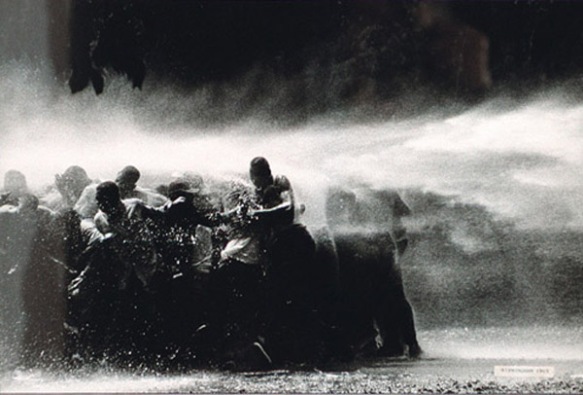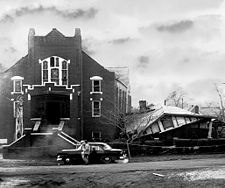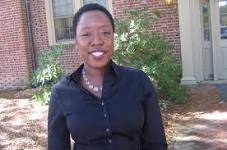The first thing I noticed when arriving at Birmingham’s Bethel Baptist Church of Collegeville today for the “homegoing” service of the Rev. Lamar Weaver, 85, was the hearse from Poole’s Funeral Chapels, Inc.
How fitting since it was the Poole brothers, Ernest and John, who helped save Weaver’s life 56 years ago.
On March 6, 1957, a day after the Alabama Public Commission ruled that waiting rooms designated for interstate travel must remain segregated, Weaver met the Rev. Fred Shuttlesworth, Birmingham’s formidable civil rights leader and Bethel’s pastor, and his wife, Ruby, at Terminal Station. The Shuttlesworths had bought tickets to Atlanta and sat in the whites-only waiting room in defiance of the ruling. Weaver, a white man, had come to the station to show his support. As the Shuttlesworths and Weaver waited for the train, a crowd of about 100 segregationists, led by “Dynamite Bob” Chambliss (one of the men responsible for bombing the 16th Street Baptist Church in 1963), began to harass them. Before long, police ordered all those without tickets to leave the waiting room, and this included Weaver. In his 2001 autobiography, “Bury My Heart in Birmingham,” Weaver recounted that long walk to his car:
A police officer pushed me out on to the sidewalk and the door closed behind me. I was surrounded by this angry mob. I was terrified. I turned toward the area where my car was parked and started walking slowly to my car. The mob was so close to me; I could feel their hot breath on the back of my neck. I knew if I ran I would most certainly be killed much like a pack of wild dogs would do when they chase after prey. Then suddenly, someone hit me from behind with a suitcase and knocked me to the ground. Some of the persons in the mob began kicking me. I struggled back to my feet trying desperately to make it to my car. The mob followed me. The news media were there taking pictures. Thank God for those reporters. If they had not been there with their cameras, I’m sure I would have been killed. Getting to my car seemed like an eternity. Finally I made it and managed to somehow get inside.
The hostile crowd threw cement blocks and rocked the vehicle, attempting to flip it over. Weaver described Chambliss being at the front of his car, sneering and cursing while rocking it.
Weaver managed to back up but not before someone in the crowd opened the car door and began beating him. A reporter from a national media outlet pushed the man away and Weaver was able to speed off. However, the police charged Weaver with running a red light and reckless driving. He opted for an immediate trial and was able to stand before a city judge that day. The judge fined Weaver $25 and ordered him to leave town.
The Poole brothers paid Weaver’s fine, hid his car and drove him to the funeral home. Here’s Weaver’s account of what happened next:
I hid there for the rest of the day and that night. A Negro informant told the police that I was hiding at the Poole Funeral Home. When they couldn’t find me there, the mob continued their search for me throughout the city. At least twice during the late hours of the night, angry Whites came into the funeral home looking for me. [Three employees] of the Poole Funeral Home had hidden me in a casket.
According to Weaver, the next day, he was taken to the airport and flew to Washington, D.C. to testify before the U.S. Senate subcommittee on civil rights. (He had made his airplane reservations under the pseudonym James Bishop to remain hidden.) While waiting to testify, Weaver was told by his congressional representative, “Don’t ever go back to Birmingham. You’ll never be welcomed. You are a disgrace. You are the most hated white man in the south.” Weaver did not let the representative’s words deter him from testifying.
Weaver’s deeds were not without consequences. He had made many enemies, especially when he decided to run against Eugene “Bull” Connor for his seat on the Birmingham City Commission. During his campaign, a bullet was fired into his house, almost hitting one of his daughters. Soon after, his first wife divorced him and moved to north Alabama. Weaver also lost the election to Connor.
During today’s eulogy for Weaver, Bethel’s current pastor, the Rev. Thomas L. Wilder, Jr., asked, “Why would a white man in the middle of segregated Birmingham risk everything?” Wilder told the small group of mourners of an event that Weaver witnessed at a young age that may have been the impetus for his life’s work. In Weaver’s words:
I was about four years old and we were traveling down an old dirt road near [Centre], Alabama. I thought it must have been on the weekend because as we approached a crossroad I saw a large group of people standing around in a festive atmosphere. There were so many people that they were partially blocking the road. As we drew closer, I was not prepared for what I was about to see. I witnessed one of the most horrific things I have ever seen even to this day. What I witnessed was a horrible experience for me. As our car stopped, we saw some White men, some dressed in robes, standing on platform with a Negro boy who I think could have been anywhere from fifteen to eighteen years old. There he was standing stripped of his clothing and the Whites were savagely beating him. Then they brought out axes and they began hacking his body to pieces, killing him before our very eyes. It was like a slaughterhouse. Blood was everywhere. My father, mother and I watched in horror. I just sat there horrified. It was a sight I will remember for the rest of my life. Looking back now, that experience made an impact on my life that may have been the reason my life took the path that it did.
“Please for the rest of your life, remember Rev. Lamar Weaver. Remember those who risked it all for the sake of the cause,” Wilder admonished us.
Weaver’s son, Robert Lamar, also spoke at today’s service. He reminded everyone of the circular nature of life. Weaver, who had been living in Kennesaw, Ga., had once again returned to Birmingham, the city he loved and fought to change. “And today, with God’s plan, we will bury my father’s heart in Birmingham.”

Weaver shakes hands with Shuttlesworth as Shuttlesworth’s first wife, Ruby, looks on. Weaver was on hand at Birmingham’s Terminal Station to show support of the couple as they waited for their train to Atlanta in the whites-only waiting room. Credit: Birmingham News/Alabama Media Group

A mob surrounds Weaver’s car as he attempts to leave the terminal. Credit: Birmingham News/Alabama Media Group






